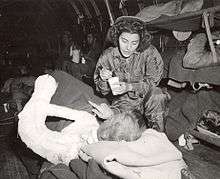Flight nurse
A flight nurse is a registered nurse who specialises in the field of providing comprehensive pre-hospital, emergency critical care, and hospital care to a vast scope of patients. The care of these patients is generally during aeromedical evacuation or rescue operations aboard helicopters, propeller aircraft or jet aircraft. On board a rescue aircraft you would find a flight nurse accompanied by flight medics and respiratory practitioners, as well as the option of a flight physician for comprehensive emergency and critical transport teams. The inclusion of a flight physician is more commonly seen in pediatric and neonatal transport teams.[2]

Roles and duties
A flight nurse is required to complete a copious amount of duties each and every call out. Listed below is a comprehensive list of these duties and responsibilities:
- Flight nurses perform as a member of an aeromedical evacuation team on helicopters and propeller or jet aircraft
- Responsible for planning and preparing for aeromedical evacuation missions
- Expedite mission and initiate emergency treatment in absence of Flight Physician
- Provide in-flight management and nursing care for patients
- Evaluate individual patient in-flight needs
- Liaison between medical and operational aircrews and support personnel to promote patient comfort
- Responsible for maintaining patient care, comfort and safety
- Care for patients with both medical and traumatic issues
- Request appropriate medications, supplies and equipment to provide care to patient
- Must have training in mechanical ventilation, hemodynamic support, vasoactive medications and intensive care skills
- Specialised clinical skills in union with knowledge, theory, education and expertise in hospital and pre-hospital environments are required [3]
- Perform advanced medical procedures without supervision of a doctor such as intubation, ventilator management, chest tube insertion, intra-osseous line placement, central line placement, intra-aortic balloon pump management, management of pacing devices, titration of vasoactive medications, pain management, administration of anaesthetic medications for intubation, and in some cases, emotional and family care [2]
Education
National requirements for most flight nurse programs include:
- License as a registered nurse
- 2–3 years of critical care experience and/or mobile intensive care unit (MICU) experience.
- Advanced cardiac life support (ACLS) certificate
- Pediatric advanced life support (PALS) certificate[2]
Additional requirements may include:
- Neonatal Resuscitation Program (NRP)
- Nationally recognised trauma program such as Pre Hospital Trauma Life (PHTLS)
- Support (PHTLS), Basic Trauma Life Support (BTLS), Trauma Nurse Core Course (TNCC), or Transport Nurse Advanced Trauma Course (TNATC)
- Certifications such as Critical Care certification (CCRN), Certified Emergency Nurse (CEN), or Certified Flight Registered Nurse (CFRN)[2]
Helpful, but may not be required:
- EMT or EMT-P (paramedic) certification with field experience (some states require flight nurses to be certified as EMTs or EMT-Ps)[2]
Credentialing
- Certified Emergency Nurse (CEN)
- Certified Flight Registered Nurse (CFRN)
- Critical Care Registered Nurse (CCRN)[2]
Types
Civilian
- Works for hospitals, federal, state and local governments, private medical evacuation firms, fire departments and other agencies.[2]
Military
- Army Air Force Evacuation Service
- Member of aeromedical evacuation crew
- Senior medical member of aeromedical evacuation team on Continental United States (CONUS)
- Works in intra-theatre and inter-theatre flights to provide in-flight management and nursing care
- Plan/Prepare aeromedical evacuation missions and prepare patient care facilitation plan[4]
In Australia
Australia has an estimated 20% of land recognised as desert with a rather small population density. Providing health care to these remote rural towns can prove to be quite laborious. Australia provides a number of organisations that flight nurses are under employment of.[3]
In United States
In the United States there are approximately 550,000 people who require emergency or standard medical transport every year.[5] Situations involving the need for patients to travel via fixed wing include patients who have been involved in a bad accident and require transport to an intensive care, patient needs a transplant, or a stable patient who has a medical condition that wants to move closer to family. Teams involved in the air transport of a patient can include nurse/nurse, nurse/paramedic, nurse/physician, nurse/respiratory therapist, or paramedic/paramedic, depending on the needs of the patient. When transporting a patient who is on vasoactive medications or vasodilator medications, the nurse is responsible for titrating the drips to maintain the hemodynamic parameter within the ordered range and the critical care needed for the patient.[6] Flight nursing plays a critical role in a transporting a critically ill patient who lives in a rural community to a hospital that has the resources necessary to provide the care needed to the patient.[7]
See also
References
- "Angels of the Airfields: Navy Air Evacuation Nurses of World War II | Naval Historical Foundation". www.navyhistory.org. Retrieved 2016-05-18.
- Jones, Joy; Young, J S (2004). "Soaring to New Heights as a Flight Nurse". Critical Care Nurse. ISSN 0279-5442.
- Brideson, G (2015). "Images of flight nursing in Australia: A study using institutional ethnography". Nursing and Health Sciences. 18 (1): 38–43. doi:10.1111/nhs.12225. PMID 26235106.
- US Air Force ROTC. "Flight Nurse". Archived from the original on 2008-06-09. Retrieved 2008-06-05.
- "Fact Sheet and FAQs". AAMS. Retrieved 2020-06-26.
- "How to Become a Flight Nurse: Duties and Outlook". Western Governors University. Retrieved 2020-06-27.
- van Lieshout, Erik Jan; Binnekade, Jan; Reussien, Elmer; Dongelmans, Dave; Juffermans, Nicole P.; de Haan, Rob J.; Schultz, Marcus J.; Vroom, Margreeth B. (2016). "Nurses versus physician-led interhospital critical care transport: a randomized non-inferiority trial". Intensive Care Medicine. 42: 1146–1154. doi:10.1007/s00134-016-4355-y. ISSN 0342-4642. PMC 4879164. PMID 27166622.
Further reading
- David M Kaniecki Acnp (2013). Operation Flight Nurse: Real-Life Medical Emergencies. David Kaniecki. ISBN 978-0-615-83996-7.
- Janice Hudson (2011). Trauma Junkie: Memoirs of an Emergency Flight Nurse. Firefly Books. ISBN 978-1-77088-004-7.